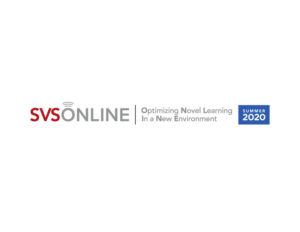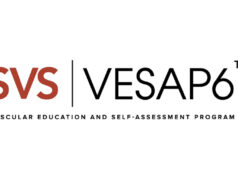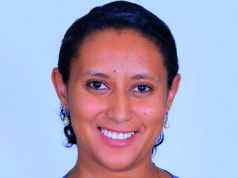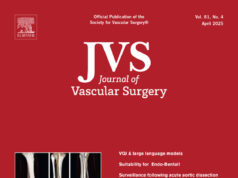
As Society for Vascular Surgery (SVS) Postgraduate Education Committee chair Vikram Kashyap, MD, tells it, the organizers behind programming for the Vascular Annual Meeting (VAM) had never before been confronted with such a mammoth task.
Like it did in all but a handful of areas of public life, the novel coronavirus landed like a wrecking ball on the vascular conference circuit, and VAM, the flagship event on the SVS calendar, had become yet another victim.
That sparked an almighty pivot, Kashyap explains—a brisk turnaround that birthed a virtual replacement for this year’s iteration of the annual event: SVS ONLINE, or Optimizing Novel Learning In A New Environment, which kicks off June 20 for a two-week run.
For Kashyap, this meant getting to work with some haste in order to re-tool the elements of the event organized by the Postgraduate Education Committee.
It’s a process of which the chief in the division of vascular surgery and endovascular therapy at University Hospitals Cleveland Medical Center in Cleveland and his committee members are proud.
“This has probably been the largest pivot in SVS history for the annual meeting, taking a completely live program and turning it into a series of live webinars,” Kashyap tells Vascular Specialist. “Having interaction with our membership in a virtual manner to this degree has never been done before.
“So we came up with the moniker SVS ONLINE. We think this highlights a new approach—and hopefully one that keeps our SVS members engaged and up-to-date.”
Traditionally, VAM is composed of both a scientific strand developed by the Program Committee and invited sessions, the part organized by Kashyap and the Postgraduate Education Committee.
 “We had a spectacular number of invited sessions slated for the VAM this year: a three-hour postgraduate course, six 90-minute breakfast sessions; ask-the-experts, small-group sessions that were to be one-hour interactive sessions where you would find out tips and tricks, how to do certain types of cases, and how to take care of certain types of patients,” Kashyap explains.
“We had a spectacular number of invited sessions slated for the VAM this year: a three-hour postgraduate course, six 90-minute breakfast sessions; ask-the-experts, small-group sessions that were to be one-hour interactive sessions where you would find out tips and tricks, how to do certain types of cases, and how to take care of certain types of patients,” Kashyap explains.
“And then, at the time we were formulating VAM, we had seven—it was going to expand likely to eight—concurrent programs 90 minutes in length, highlighting things as disparate as telemedicine, leadership and different clinical aspects of taking care of vascular patients. All of that was ready to go before COVID changed everyone’s plans.”
For SVS ONLINE, that line-up has been pared back to include seven broad topic areas that can be covered in an hour. Each session will see three to four experts conduct around 30 minutes of pre-recorded didactics followed by 15 minutes each of both panel discussion and an online Q&A.
“What we did was solicit feedback from our members, and, quite frankly, a lot from our committee members as to what would be compelling material for a virtual format,” says Kashyap.
The guiding rationale zeroed in on ensuring members would be properly engaged and that the topics would lead to quality discussion in the virtual sphere.
The seven sessions cover the management of type II endoleaks; digital health advancements in vascular surgery; current controversies in endovascular therapy for peripheral arterial disease (PAD); a debate around whether aggressive clot debulking is needed for deep vein thrombosis/submassive pulmonary embolisms; spine exposure for the vascular surgeon; enhancing wellness in times of chaos; and challenges and controversies in hemodialysis access. Dates and times for each of the sessions are still being finalized.
Kashyap is cognizant of the paradigm shift the move to a virtual event represents.
“I think I’ll be the first one to raise my hand: We’re all in a funk coping with the COVID crisis,” he admits. “We’re all in uncharted, unprecedented times. We’re all trying to navigate this as best as we can. VAM is such a special meeting. We’ll maybe find out next year that all of us who thought going to a meeting was a chore—we have work to do; this was taking time away from family—that we will be rejoicing to see our friends and colleagues live in 2021!
“SVS ONLINE is a necessary substitute for the live VAM experience. We completely understand we cannot replicate the live experience but we’re trying to bring education, science, and important, relevant and timely information to our members as quickly as we can—and do it in a way that hopefully engages our membership, understanding that many will have other commitments.”
That said, Kashyap accentuates the opportunities SVS ONLINE presents.
“We understand this is almost an experiment,” he says. “But I’m pretty confident we’ve put together as good an educational program as we can in a virtual environment. We’ve got great science from the abstracts, we’ve got great invited speakers, and we’re going to engage our industry partners to also provide non-CME [continuing medical education] content. And, we may find out that the SVS ONLINE platform can be incorporated into future SVS educational programs.”
The invited sessions were put together by Kashyap and the entirety of the Postgraduate Education Committee, including Will Robinson, MD; John Adams, MD; Donald Baril, MD, John Carson, MD; Mark Conrad, MD; Anahita Dua, MD; Audra Duncan, MD; Mark Farber, MD; Benjamin Jackson, MD; Jeffrey Jim, MD; Linda Le, MD; Raghu Motaganahalli, MD; Patrick Muck, MD; Bala Ramanan, MD; Christopher Smolock, MD; Tim Wu, MD; Jayer Chung, MD; Eric Hager, MD; Matthew Smeds, MD; and Benjamin W. Starnes, MD. “SVS staff members Jane Baque and Angela Churilla provided tremendous programmatic support,” added Kashyup.












